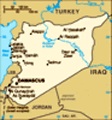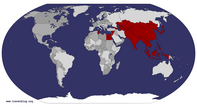Advertisement
Published: April 24th 2009
After Palmyra, we headed back westward to the town of Hama. Hama is known for its large
norias or waterwheels. The
norias were once used to raise water from the low-lying Orontes river into aqueducts that delivered the water to agricultural areas and gardens.
The main attaction of Hama for us was as a jumping off point for sites in the region. We also enjoyed many cheap ($1) tasty chicken shwarmas.
Krak des Chevaliers is a large castle that was once of great strategic importance. Whoever occupied this post overlooking the Homs Gap (break between the mountains to the north and the Lebanese mountains to the south) could more or less control the flow of goods between the coast and inland Syria. As you might imagine, the view from Krak is stunning.
Approaching Krak from the east, there is a sudden change in scenery from the scrubby desert terrain of the interior to a more coastal green. Certainly the most lush terrain we had seen in the last couple of months.
The original fortress was built by the Emir of Homs in the 11th century. Invading Crusaders took over in the 12th century, however, and the Knights
Hospitaller were responsible for expanding Krak into its current form.
We saw numerous castles in Jordan, Syria and eventually Lebanon and we poked around inside a few of them. If you only decide to see the inside of one castle, and we wouldn't blame you if you did, 'cause most of them are pretty ho-hum unless you are a student of these things or happen to be with a really good guide, Krak is possibly your best choice. It is quite well preserved. You can still grasp the functions of different parts of the structure such as the church, the toilets, stables, kitchen and storage rooms.
We also visited the Dead Cities of Apamea, Al-Bara and Serjilla from Hama.
Apamea is a gorgeous hilltop site. Like Palmyra, it was a Seleucid settlement that was eventually seized by the Romans. Unlike pinky Palmyra, however, Apamea is entirely constructed of grey granite and framed by lush green grassland instead of parched desert.
Surrounded by rich pasture, Apamea was once known for its horses. The main highlight of the site is the two kilometre long cardo or main street that runs north-south and is lined with columns and facades.
Some of the columns have twisted fluting, a uniquely Apamean design.
The Al-Bara site is large and extensively cultivated. The parts we saw, the remains of a church and two pyramid tombs, were completely surrounded by olive trees, fruit trees, bushes and wildflowers. Piles of half-buried, overgrown ruins can be seen in every direction. A person could easily spend days wandering around the site; an archeologist could probably discover historically significant artifacts.
Serjilla is a beautiful place. Considering that it has been abandoned for around 15 centuries, Serjilla has a remarkable number of well-preserved buildings.
Our next stop was Aleppo. Aleppo is another large, ancient Syrian city full of history. The Aleppo souq is really charming. Unfortunately, souq was the other place besides Palmyra that had silly tourist touts and a certain amount of harassment going on.
On our first day exploring the souq, we fell into conversation with a charming man who told us about the history of the souq and Aleppo. He invited us to his place for tea, showed us his family sweatshop where thousands of undergarments were being sown together by three men and their child assistants in a literally windowless underground
stone cavern. Of course it all ended in a back room that looked suspiciously like a store and then the hard sell kicked in! We politely drank our free tea and ran.
On a day trip out of Aleppo, we took the service taxi (shared minibus) out to a place called Qala'at Samaan or St Simeon's basilica. The very pious Simeon (born 392 AD) started out at a monastery, but found life there too cushy. Instead, he headed for a more austire, solitary life in a cave.
Hearing about this pious man, people began to come around to seek his blessing. Simeon resented this attention and began living on pillars to avoid contact with people. He started out on a three metre high pillar, but as time went on and his popularity increased, he moved to higher and higher pillars. Eventually inhabiting a pillar 18 metres high. Legend has it that St Simeon spent the better part of 40 years of his life living on pillars.
The chunk of stone in one of the photos is said to be what is left of St Simeon's last pillar, having been chipped away at for holy souvenirs by centuries

 krak church
krak church
krak des chevaliersof pilgrims.
It was such a stunning day and we wanted to stretch our legs a bit, so we decided to walk the few kilometres back to the main village near Qala'at Samaan. Syria is one of those places where people rarely walk for exercise, but primarily out of necessity. As a result, there was a fairly constant barage of honks from passing minibuses looking for fairs. And looking quite puzzled when we didn't accept the rides.
Just as our quiet walk in the country was getting increasingly annoying as we were being slowly choked with van and motorcycle exhaust (no AirCare here), a little silver battered VW pulled up with two people inside. The driver, speaking accented but fluent English, asked us where we were going and insisted that we come with them. We did as we were told.
Wouldn't you know, the man and woman in the front seat were natives of Aleppo and both tour guides. The passenger, a young woman by the name of Lena, was a former student of Fathi, the driver, tour guide and professor of history. They were out for the day having some on-site refreshers on Syrian history and
architecture for the benefit of Lena, who had a two week tour coming up with some American visitors.
We made one more stop before heading back to Aleppo, a Byzantine church plonked in the middle of scruby pasture with villagers looking on. Fathi explained the significance of the shape of the church and the locations of the entrances and how you can tell Byzanstine stone work from other based on the size of the stones (generally speaking: large).
Syria has extensive scatterings of ruins dotting the countryside. The major sites are have admission shacks but mainy of them are just out there somewhere. Child sheperds wandering through with their herds of goats and sheep; villagers tending their olive trees. It's pretty neat.
We hopped back in the car and headed for city. Again, Fathi insisted that we join them for a visit to the National Museum. Matt and i are not generally big museum-goers east of Europe since they are often poorly-signed, signed in some impossible-to-us language or disorganised or both, but with a tour guide in charge, it seemed like the thing to do.
And interesting it was. Fathi's knowledge was far beyond what we
could realistically take in in a couple of hours, but we got a grasp of the advanced ancient civilisations that once inhabited Syria.
After all that hard work, the four of us headed for a delicious late lunch of kofte, essentially lamb meatballs, sauce and greens wrapped in Arabic bread.
Then it was off to al-Jdeida, Aleppo's old Christian quarter. As most of the Christians have since moved on to a newer neighbourhood, the quarter is now primarily inhabited by Muslim families and businesses. Like Damascus, Aleppo's Christian quarter is the place in town to find the fancy licenced high-end tourist restaurants.
We were told that Syria once had a sizeable Christian population, but the typical Christian family size has dropped to just two kids whereas a typical Muslim family, even in the cities, is still generally larger. It has caused a major population shift in a matter of a couple of generations.
In al-Jdeida, we stopped into a Greek Orthodox church and the Armenian Cathedral of the 40 Martyrs with its beautiful artwork.
With thanks we said good-bye to Fathi and then there was just one more stop: Lena graceously set me up with
a hairdresser. My first haircut in six months! Ah, the small thrills of travel.
We had a couple more days to relax and enjoy Aleppo before heading off for Lebanon. We stuffed ourselves with falafel, chicken shwarmas, fresh fruit smoothies, creamy hommous and, our favourite, hot bowls of morning
fuul, an unlikely but delicious concoction of beans with garlicy-lemon juice and yoghurt slathered in olive oil and scooped up with Arabic flatbread and washed down with sweet black tea.
It's hard to explain why we liked Syria so much. Something about people being very welcoming and curious about tourists and yet not just trying to sell us crap. We seemed to pay local prices for most items. And once you get used to the total lack of privacy--unabashed staring and people asking very direct and often personal questions--it's really fun.
Advertisement
Tot: 0.172s; Tpl: 0.018s; cc: 13; qc: 67; dbt: 0.0707s; 1; m:domysql w:travelblog (10.17.0.13); sld: 1;
; mem: 1.2mb
























Deb/Mom
non-member comment
Syria
The photos are stunning. The waterwheels are amazing......may be a painting some day (with permission from the photographer, of course!). You seem to have the best luck in meeting up with people that make the trip so interesting, and helpful! Looking forward to the next installment. Would like to see a picture of Matthew some time.........xoxo to you both!